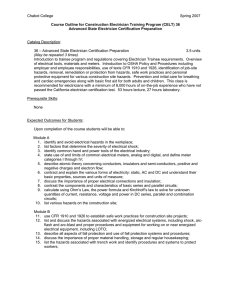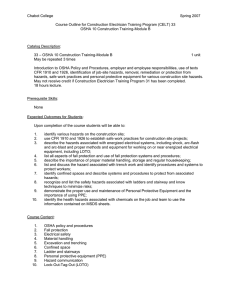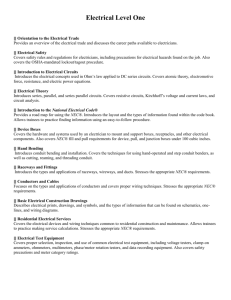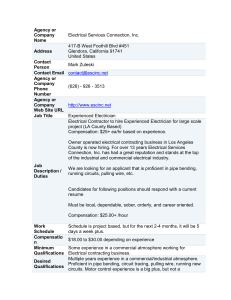Chabot College Spring 2007
advertisement
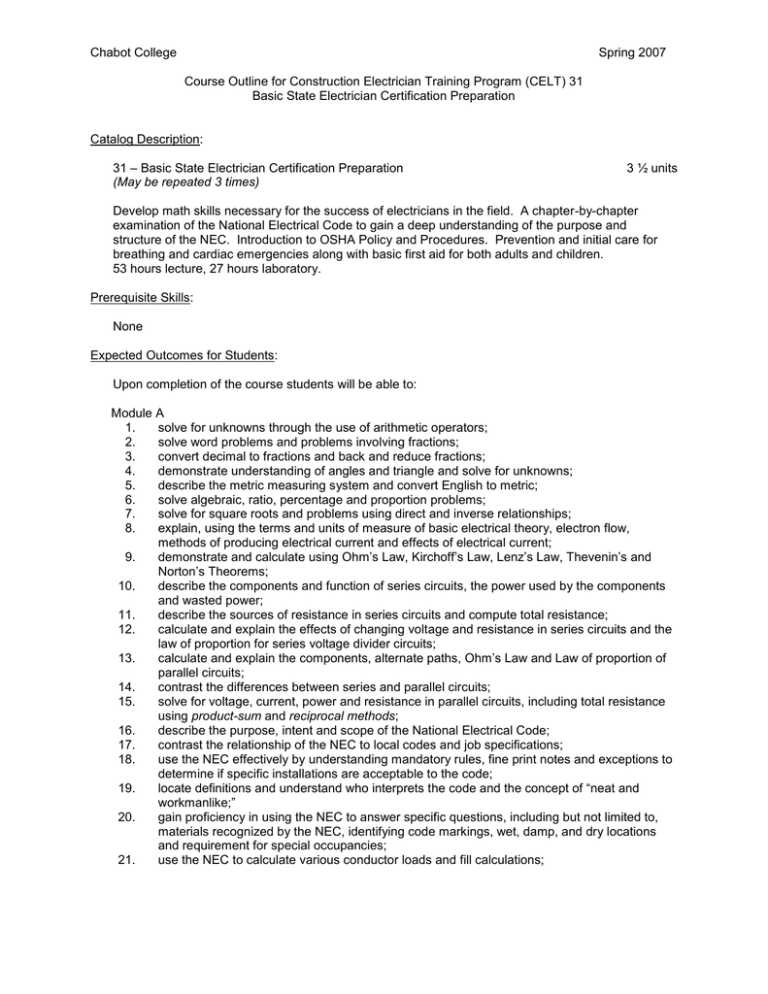
Chabot College Spring 2007 Course Outline for Construction Electrician Training Program (CELT) 31 Basic State Electrician Certification Preparation Catalog Description: 31 – Basic State Electrician Certification Preparation (May be repeated 3 times) 3 ½ units Develop math skills necessary for the success of electricians in the field. A chapter-by-chapter examination of the National Electrical Code to gain a deep understanding of the purpose and structure of the NEC. Introduction to OSHA Policy and Procedures. Prevention and initial care for breathing and cardiac emergencies along with basic first aid for both adults and children. 53 hours lecture, 27 hours laboratory. Prerequisite Skills: None Expected Outcomes for Students: Upon completion of the course students will be able to: Module A 1. solve for unknowns through the use of arithmetic operators; 2. solve word problems and problems involving fractions; 3. convert decimal to fractions and back and reduce fractions; 4. demonstrate understanding of angles and triangle and solve for unknowns; 5. describe the metric measuring system and convert English to metric; 6. solve algebraic, ratio, percentage and proportion problems; 7. solve for square roots and problems using direct and inverse relationships; 8. explain, using the terms and units of measure of basic electrical theory, electron flow, methods of producing electrical current and effects of electrical current; 9. demonstrate and calculate using Ohm’s Law, Kirchoff’s Law, Lenz’s Law, Thevenin’s and Norton’s Theorems; 10. describe the components and function of series circuits, the power used by the components and wasted power; 11. describe the sources of resistance in series circuits and compute total resistance; 12. calculate and explain the effects of changing voltage and resistance in series circuits and the law of proportion for series voltage divider circuits; 13. calculate and explain the components, alternate paths, Ohm’s Law and Law of proportion of parallel circuits; 14. contrast the differences between series and parallel circuits; 15. solve for voltage, current, power and resistance in parallel circuits, including total resistance using product-sum and reciprocal methods; 16. describe the purpose, intent and scope of the National Electrical Code; 17. contrast the relationship of the NEC to local codes and job specifications; 18. use the NEC effectively by understanding mandatory rules, fine print notes and exceptions to determine if specific installations are acceptable to the code; 19. locate definitions and understand who interprets the code and the concept of “neat and workmanlike;” 20. gain proficiency in using the NEC to answer specific questions, including but not limited to, materials recognized by the NEC, identifying code markings, wet, damp, and dry locations and requirement for special occupancies; 21. use the NEC to calculate various conductor loads and fill calculations; Chabot College Course outline for CELT 31, page 2 Spring 2007 22. 23. 24. calculate branch circuit size, disconnecting means and overcurrent protection for motors and phase converters; describe the purpose and function of grounding systems; use the NEC to determine class and division of hazardous locations and to choose the correct methods and materials for such installations. Module B 25. identify various hazards on the construction site; 26. use CFR 1910 and 1926 to establish safe work practices for construction site projects; 27. describe the hazards associated with energized electrical systems, including shock, arc-flash and arc-blast and proper methods and equipment for working on or near energized electrical equipment, including LOTO; 28. list all aspects of fall protection and use of fall protection systems and procedures; 29. describe the importance of proper material handling, storage and regular housekeeping; 30. list and discuss the hazard associated with trench work and identify procedures and systems to protect workers; 31. identify confined spaces and describe systems and procedures to protect from associated hazards; 32. recognize and list the safety hazards associated with ladders and stairway and know techniques to minimize risks; 33. demonstrate the proper use and maintenance of Personal Protective Equipment and the importance of using PPE; 34. identify the health hazards associated with chemicals on the job and learn to use the information contained on MSDS sheets. Module C 35. demonstrate a basic understanding of the initial care needed involving rescue breathing and cardiac emergencies; 36. demonstrate a firm knowledge of rescue breathing and CPR - cardio pulmonary resuscitation techniques and demonstrate a competence in rescue breathing and CPR; 37. discuss the basics of foreign body airway obstruction; 38. identify stroke and angina symptoms and be able to administer care and have a basic knowledge of emergencies involving submersion; 39. demonstrate and discuss basic first aid techniques involving: a. initial care for injured patients b. moving injured patients correctly c. burns, wounds and bleeding d. shock, seizures, diabetic emergencies, drug overdoses, poisoning e. musculoskeletal injuries and eye injuries f. insect bites and stings, snake bites g. temperature related problems. Course Content: Module A 1. Basic math, including decimals, fractions, proportions, percentages, metric measurements, conversion to metrics, basic algebra and geometry 2. Basic electrical theory, including electrical production, series and parallel circuit components and function 3. The scope, purpose and use of the National Electrical Code to design and build electrical systems that are free of hazards Chabot College Course outline for CELT 31, page 3 Spring 2007 Module B 4. OSHA policy and procedures 5. Fall protection 6. Electrical safety 7. Material handling 8. Excavation and trenching 9. Confined space 10. Ladder and stairways 11. Personal protective equipment (PPE) 12. Hazard communication 13. Lock-Out-Tag-Out (LOTO) Module C 14. Adult basic life support techniques 15. Demonstration of CPR using manikins 16. Student demonstrations of proper CPR technique 17. Basic first aid techniques 18. Student demonstrations of proper first aid techniques 19. Red Cross first aid and CPR course materials Methods of Presentation: 1. 2. 3. 4. 5. 6. 7. Lecture Class discussion Films PowerPoint presentation Classroom Performance System Testing (immediate feedback) Homework Interactive question and answer Assignments and Methods of Evaluating Student Progress: 1. 2. Typical Assignments a. Referring to reading and lecture notes, build a parallel lighting circuit using 8 – 100 watt bulbs. b. Measure current flows and determine code wiring and protective circuit. Methods of Evaluating Student Progress: a. Classroom Performance System Test b. Homework c. Written quizzes and tests including final examination Textbooks: 1. 2. 3. 4. 5. 6. National Electrical Code 1999 Mike Holt’s Illustrated Guide Electrician’s Exam Preparation CRF 1926 with excerpts from CRF 1910 OSHA 10 Workbook Red Cross handouts, pamphlets and reading materials Coyne First Aid handouts and reading materials Special Student Materials: None BBenton/CELT 31 Sept 2006, revised 10/13/06 Course # chg 11/7/06
